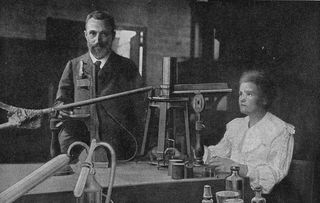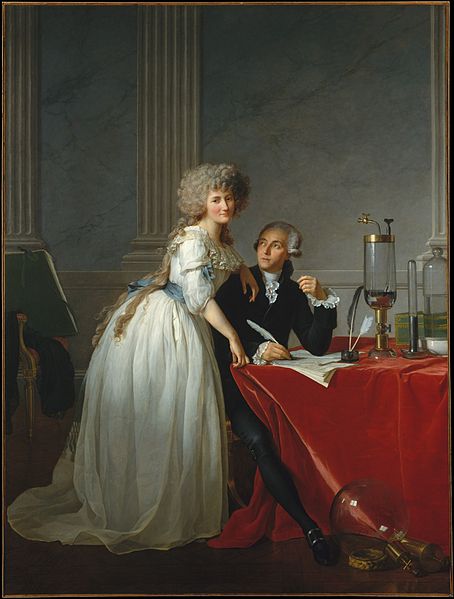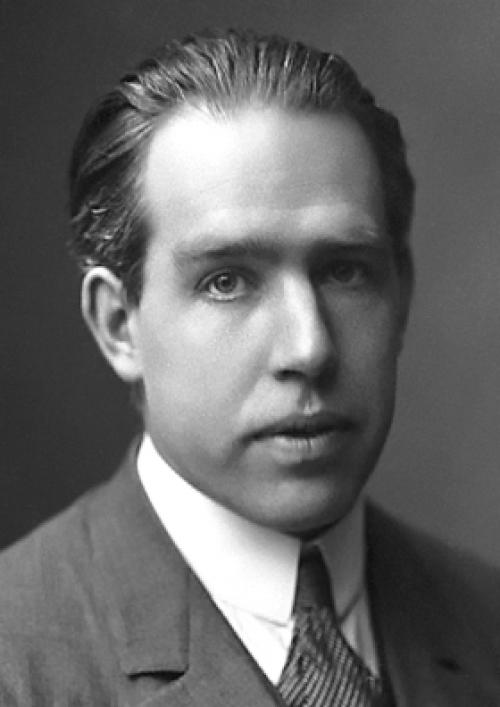Who Developed An Argument That Was Based On The Changing Properties Of Wax?
History of Chemistry | Famous Chemists

In many means, the history of civilization is the history of chemistry — the report of matter and its properties. Humans have always sought to identify, apply and change the materials in our environment. Early potters found beautiful glazes to decorate and preserve their wares. Herdsmen, brewers and vintners used fermentation techniques to make cheese, beer and wine. Housewives leached the lye from wood ash to make lather. Smiths learned to combine copper and tin to make bronze. Crafters learned to make glass; leatherworkers tanned hides.
In the eighth century A.D., Jābir ibn Hayyān, a Muslim astronomer, philosopher and scientist, became i of the start to use scientific methods to study materials. Too known by his Latinized name, Geber, he is known as the "father of chemistry." He is idea to exist the author of 22 scrolls describing methods of distillation, crystallization, sublimation and evaporation. He invented the alembic, a device used to dribble and written report acids. He also adult an early chemic nomenclature arrangement using the backdrop of the materials he studied. His categories were:
- "Spirits" — materials that would vaporize when heated.
- "Metals" — including iron, tin can, copper, and lead.
- Not-malleable substances — materials that could be fabricated into powders, such as stone.
Today nosotros might call similar materials "volatile chemicals, metals and not-metals."
Classical chemistry
In Europe, the written report of chemical science was conducted by alchemists with the goals of transforming common metals into gilded or silvery and inventing a chemic elixir that would prolong life. Although these goals were never accomplished, at that place were some important discoveries made in the try.
Robert Boyle(1627-1691) studied the beliefs of gases and discovered the inverse relationship between volume and force per unit area of a gas. He also stated that "all reality and modify tin can be described in terms of simple particles and their motion," an early understanding of atomic theory. In 1661, he wrote the first chemistry textbook, "The Sceptical Cymist," which moved the written report of substances away from mystical associations with alchemy and toward scientific investigation.
By the 1700s, the Historic period of Enlightenment had taken root all over Europe. Joseph Priestley (1733-1804) disproved the idea that air was an indivisible element. He showed that information technology was, instead, a combination of gases when he isolated oxygen and went on to discover seven other discreet gases. Jacques Charlescontinued Boyles' piece of work and is known for stating the direct relationship between temperature and force per unit area of gases. In 1794, Joseph Proust studied pure chemical compounds and stated the Constabulary of Definite Proportions — a chemical compound will always have its own characteristic ratio of elemental components. H2o, for instance, always has a two-to-1 ratio of hydrogen to oxygen.

Antoine Lavoisier (1743-1794) was a French chemist who fabricated important contributions to the scientific discipline. While working as a tax collector, Lavoisier helped to develop the metric organisation in order to insure uniform weights and measures. He was admitted to the French Academy of Sciences in 1768. 2 years after, at age 28, he married the 13-year-erstwhile daughter of a colleague. Marie-Anne Lavoisier is known to have assisted her husband in his scientific studies past translating English language papers and doing numerous drawings to illustrate his experiments.
Lavoisier's insistence on meticulous measurement led to his discovery of the Law of Conservation of Mass. In 1787, Lavoisier published "Methods of Chemical Classification," which included the rules for naming chemical compounds that are still in use today. His "Uncomplicated Treatise of Chemistry" (1789) was the first modern chemical science textbook. It clearly defined a chemical element as a substance that cannot be reduced in weight by a chemic reaction and listed oxygen, iron, carbon, sulfur and most xxx other elements so known to be. The volume did have a few errors though; it listed light and heat as elements.
Amedeo Avogadro (1776-1856) was an Italian lawyer who began to report science and mathematics in 1800. Expanding on the work of Boyle and Charles, he clarified the difference between atoms and molecules. He went on to country that equal volumes of gas at the same temperature and pressure have the same number of molecules. The number of molecules in a ane-gram molecular weight (1 mole) sample of a pure substance is chosen Avogadro'due south Constant in his honor. It has been experimentally determined to exist 6.023 x 1023 molecules and is an important conversion factor used to make up one's mind the mass of reactants and products in chemical reactions.
In 1803, an English meteorologist began to speculate on the phenomenon of water vapor. John Dalton (1766-1844) was aware that water vapor is part of the atmosphere, but experiments showed that water vapor would not form in certain other gases. He speculated that this had something to do with the number of particles present in those gases. Peradventure there was no room in those gases for particles of water vapor to penetrate. There were either more particles in the "heavier" gases or those particles were larger. Using his ain data and the Police force of Definite Proportions, he adamant the relative masses of particles for vi of the known elements: hydrogen (the lightest and assigned a mass of 1), oxygen, nitrogen, carbon, sulfur and phosphorous. Dalton explained his findings by stating the principles of the first atomic theory of affair.
- Elements are composed of extremely small particles called atoms.
- Atoms of the aforementioned element are identical in size, mass and other backdrop. Atoms of different elements take different properties.
- Atoms cannot be created, subdivided or destroyed.
- Atoms of different elements combine in simple whole number ratios to form chemical compounds.
- In chemical reactions atoms are combined, separated or rearranged to course new compounds.
Dmitri Mendeleev (1834-1907) was a Russian pharmacist known for developing the start Periodic Table of the Elements. He listed the 63 known elements and their properties on cards. When he arranged the elements in order of increasing atomic mass, he could grouping elements with similar backdrop. With a few exceptions, every seventh element had similar properties (The eighth chemical group — the Noble Gases — had not been discovered all the same). Mendeleev realized that if he left spaces for the places where no known element fit into the pattern that it was even more exact. Using the blank spaces in his table, he was able to predict the properties of elements that had yet to exist discovered. Mendeleev's original table has been updated to include the 92 naturally occurring elements and 26 synthesized elements.
Describing the atom
In 1896, Henri Becquerel discovered radiation. Forth with Pierre and Marie Curie, he showed that certain elements emit free energy at fixed rates. In 1903, Becquerel shared a Nobel Prize with the Curies for the discovery of radioactivity. In 1900, Max Planck discovered that free energy must be emitted in discreet units that he called "quanta" (since named photons) not in continuous waves. It appeared that atoms were fabricated up of still smaller particles, some of which could move away.
In 1911, Ernst Rutherford demonstrated that atoms consisted of a tiny dense positively charged region surrounded past relatively large areas of empty space in which nonetheless smaller, negatively charged particles (electrons) motion. Rutherford assumed that the electrons orbit the nucleus in carve up slap-up orbits, just as the planets orbit the sun. Nonetheless, because the nucleus is larger and denser than the electrons, he could not explain why the electrons were not simply pulled into the nucleus thus destroying the cantlet.

Niels Bohr'due south (1885-1962) atomic model solved this problem by using Planck's information. Photons are emitted from an electrically stimulated atom only at certain frequencies. He hypothesized that electrons inhabit distinct energy levels and light is merely emitted when an electrically "excited" electron is forced to change energy levels.
Electrons in the first energy level, closest to the nucleus, are tightly leap to the nucleus and have relatively low energy. In levels more distant from the nucleus the electrons have increasing energy. Electrons in the energy level furthest from the nucleus are not bound as tightly and are the electrons involved when atoms bond together to grade compounds. The periodic nature of the elemental backdrop is a consequence of the number of electrons in the outer energy level that can be involved in chemical bonds. Although Bohr models take been replaced by more accurate diminutive models, the underlying principles are audio and Bohr models are still used as simplified diagrams to testify chemical bonding.
Our understanding of the cantlet has continued to exist refined. In 1935, James Chadwick was awarded the Nobel Prize for his discovery that there are an equal number of electrically neutral particles in the nucleus of an atom. Since neutrons are electrically neutral, they are non deflected by either electrons or protons. Furthermore, neutrons have more mass than protons. These facts combine to arrive possible for neutrons to penetrate atoms and interruption autonomously the nucleus, releasing vast amounts of energy. In recent years, it is increasingly obvious that the protons, neutrons and electrons of classical chemistry are made up of still smaller subatomic particles. The sciences of chemistry and physics are condign increasingly intertwined and theories overlap and conflict as nosotros continue to probe the materials out of which our universe is made.
Source: https://www.livescience.com/46020-chemistry-history.html
Posted by: vasquezviess1990.blogspot.com

0 Response to "Who Developed An Argument That Was Based On The Changing Properties Of Wax?"
Post a Comment